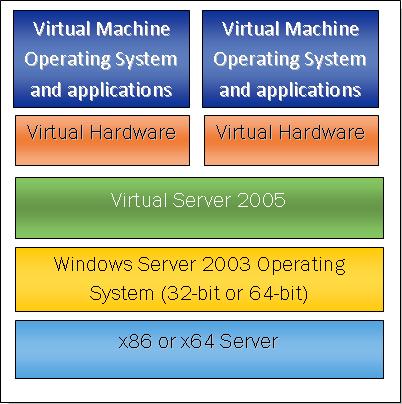Microsoft Virtual Server 2005 Architecture
Microsoft Virtual Server 2005 allows system administrators to consolidate separate hardware servers on to a single server running on Microsoft Windows Server 2003 as a host operating system.
Virtual Server 2005 is a multithreaded application that runs as a system service, with each virtual machine running in its own thread of execution. Input/output (I/O) occurs in child threads. Virtual Server derives two core functions from the host operating system: the underlying host operating system kernel schedules CPU resources, and device drivers of the host operating system provide access to system devices. Virtual Server’s Virtual Machine Monitor (VMM) provides the software infrastructure to create virtual machines, manage instances, and interact with guest operating systems.
A description of the hardware that Virtual Server 2005 emulates is contained in the Technical Overview below in Figure 1.

Virtual Server Architecture
Figure 1. Virtual Server 2005 Architecture
Above figure describes Virtual Server 2005 architecture on x86 or x64 based physical Server with Windows Server 2003 as host Operating System.

Figure 2
Figure 2. Virtual Server 2005 Architecture
The following are the key features of the Virtual Server Architecture.
Isolation
To prevent the unauthorized virtual machine access from other virtual machines and host operating system, Virtual Server isolates the virtual machines from others. In case of software problem in a virtual machine, this isolation feature enables the other virtual machines and host operating system to continue running, which result in stable and secure environment.
Encapsulation
Encapsulation means to package data and processing within a single object. In the case of virtual machines, this means that virtual machines are packaged into a single file, a virtual hard disk file, which you can easily move among host operating systems running Virtual Server. Decoupling applications from hardware through encapsulation simplifies capacity planning, deployment, and management tasks.
Compatibility
Just like a physical computer, a virtual machine hosts its own guest operating system and applications, and has all the components found in a physical computer (motherboard, VGA card, network card controller, etc). As a result, virtual machines are completely compatible with all standards x86 operating systems, applications and device drivers, so you can use a virtual machine to run all the same software that you would run on a physical x86 computer.
Hardware Independence
Virtual machines are completely independent from their underlying physical hardware. For example, you can configure a virtual machine with virtual components (e.g. CPU, network card, SCSI controller) that are completely different from the physical components that are present on the underlying hardware. Virtual machines on the same physical server can even run different kinds of operating systems.
When coupled with the properties of encapsulation and compatibility, hardware independence gives you the freedom to move a virtual machine from one type of x86 computer to another without making any changes to the device drivers, operating system, or applications. Hardware independence also means that you can run a heterogeneous mixture of operating systems and applications on a single physical computer.
Thank you for a good and simple description.
Salam